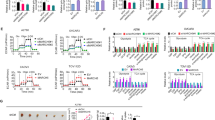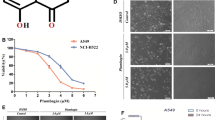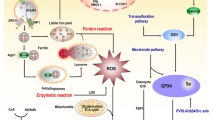Abstract
Objectives
Copper oxide nanoparticles (CuO NPs) promoting anticancer activity may be due to the regulation of various classes of histone deacetylases (HDACs).
Results
Green-synthesized CuO NPs significantly arrested total HDAC level and also suppressed class I, II and IV HDACs mRNA expression in A549 cells. A549 cells treated with CuO NPs downregulated oncogenes and upregulated tumor suppressor protein expression. CuO NPs positively regulated both mitochondrial and death receptor-mediated apoptosis caspase cascade pathway in A549 cells.
Conclusion
Green-synthesized CuO NPs inhibited HDAC and therefore shown apoptosis mediated anticancer activity in A549 lung cancer cell line.





Similar content being viewed by others
References
Appaix F, Minatchy M, Riva-Lavieille C, Olivares J, Antonsson B, Saks VA (2000) Rapid spectrophotometric method for quantitation of cytochrome c release from isolated mitochondria or permeabilized cells revisited. Biochim Biophys Acta 1457:175–181
Gupta SC, Kim JH, Prasad S, Aggarwal BB (2010) Regulation of survival, proliferation, invasion, angiogenesis, and metastasis of tumor cells through modulation of inflammatory pathways by nutraceuticals. Cancer Metastasis Rev 29:405–434
Hanagata N, Zhuang F, Connolly S, Li J, Ogawa N, Xu M (2011) Molecular responses of human lung epithelial cells to the toxicity of copper oxide nanoparticles inferred from whole genome expression analysis. ACS Nano 5:9326–9338
Jänicke RU, Ng P, Sprengart ML, Porter AG (1998) Caspase-3 is required for alpha-fodrin cleavage but dispensable for cleavage of other death substrates in apoptosis. J Biol Chem 273:15540–15545
Qian DZ, Kato Y, Shabbeer S, Wei Y, Verheul HM, Salumbides B, Sanni T, Atadja P, Pili R (2006) Targeting tumor angiogenesis with histone deacetylase inhibitors: the hydroxamic acid derivative LBH589. Clin Cancer Res 12:634–642
Ropero S, Esteller M (2007) The role of histone deacetylases (HDACs) in human cancer. Mol Oncol 1:19–25
Sankar R, Ravikumar V (2014) Biocompatibility and biodistribution of suberoylanilide hydroxamic acid loaded poly (dl-lactide-co-glycolide) nanoparticles for targeted drug delivery in cancer. Biomed Pharmacother 68:865–871
Sankar R, Maheswari R, Karthik S, Shivashangari KS, Ravikumar V (2014) Anticancer activity of Ficus religiosa engineered copper oxide nanoparticles. Mater Sci Eng C Mater Biol Appl 44:234–239
Sankar R, Karthik S, Subramanian N, Krishnaswami V, Sonnemann J, Ravikumar V (2015) Nanostructured delivery system for suberoylanilide hydroxamic acid against lung cancer cells. Mater Sci Eng C Mater Biol Appl 51:362–368
Shafagh M, Rahmani F, Delirezh N (2015) CuO nanoparticles induce cytotoxicity and apoptosis in human K562 cancer cell line via mitochondrial pathway, through reactive oxygen species and p53. Iran J Basic Med Sci 18:993–1000
Shuman Moss LA, Jensen-Taubman S, Stetler-Stevenson WG (2012) Matrix metalloproteinases: changing roles in tumor progression and metastasis. Am J Pathol 181:1895–1899
Siddiqui MA, Alhadlaq HA, Ahmad J, Al-Khedhairy AA, Musarrat J, Ahamed M (2013) Copper oxide nanoparticles induced mitochondria mediated apoptosis in human hepatocarcinoma cells. PLoS ONE 8:e69534
Sun T, Yan Y, Zhao Y, Guo F, Jiang C (2012) Copper oxide nanoparticles induce autophagic cell death in A549 cells. PLoS ONE 7:e43442
Wang G, He J, Zhao J, Yun W, Xie C, Taub JW, Azmi A, Mohammad RM, Dong Y, Kong W, Guo Y, Ge Y (2012) Class I and class II histone deacetylases are potential therapeutic targets for treating pancreatic cancer. PLoS ONE 7:e52095
Xu WS, Parmigiani RB, Marks PA (2007) Histone deacetylase inhibitors: molecular mechanisms of action. Oncogene 26:5541–5552
Acknowledgements
We thank the DST-FIST for their infrastructure support to our department. The first author thanks to Dr. K. Jayaraman, Department of Educational Technology, Bharathidasan University, Tiruchirappalli, for the constant encouragement and financial support throughout her career. The authors are grateful to Dr. C. Prahalathan and Dr. A. Antony Joseph Velanganni, Department of Biochemistry, Bharathidasan University, Tiruchirappalli, India for his help with gel documentation and fluorescence studies. Sincere thanks to Dr. S. Sivaramakrishnan, Department of Biotechnology and Genetic Engineering, for his help with gel documentation studies and cell storage.
Supporting information
Supplementary Fig. 1—Field emission-scanning electron microscopic analysis of a CuO NPs b EDAX spectrum (CuO NPs- Copper oxide nanoparticles; EDAX- Energy dispersive X-ray spectroscopy).
Supplementary Table 1—The sequence of the primers used for the RT-PCR (RT-PCR- Reverse transcription PCR).
Author information
Authors and Affiliations
Corresponding author
Ethics declarations
Conflict of interest
The authors declare that they have no conflicts of interest concerning this article.
Electronic supplementary material
Below is the link to the electronic supplementary material.
Rights and permissions
About this article
Cite this article
Kalaiarasi, A., Sankar, R., Anusha, C. et al. Copper oxide nanoparticles induce anticancer activity in A549 lung cancer cells by inhibition of histone deacetylase. Biotechnol Lett 40, 249–256 (2018). https://doi.org/10.1007/s10529-017-2463-6
Received:
Accepted:
Published:
Issue Date:
DOI: https://doi.org/10.1007/s10529-017-2463-6




